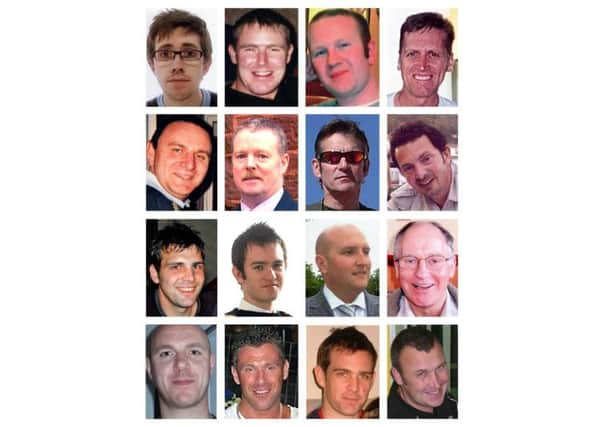Pilots give evidence at Super Puma crash inquiry


The Super Puma plunged into the sea off the Aberdeenshire coast while returning from the BP Miller platform on April 1 2009.
A fatal accident inquiry (FAI) into the crash is being held before a sheriff in Aberdeen almost five years after the incident happened.
Advertisement
Hide AdAdvertisement
Hide AdJohn Constable, 50, a trainer of helicopter pilots, and Andrew Miller, who had previously flown the helicopter involved in the tragedy, have both been giving evidence to the inquiry on its second day.
Their evidence, largely of a technical nature, has centred around the workings of some of a helicopter’s mechanics and the various procedures pilots would be familiar with.
Mr Constable was head of training for helicopter operator Bond at the time of the crash.
He told the inquiry it was an eight-week process to give a pilot who already has a commercial licence the additional knowledge to enable them to fly Super Pumas.
Helicopters also have various colour-coded warning lights, the witness told the hearing, with red being reserved for the most serious events which require immediate action.
He added that he had never had such a thing as a “gearbox chip warning light” in a Super Puma helicopter in his experience.
‘Minor’ problems
Mr Miller, 47, who flew the helicopter in question on its last completed journey, yesterday told the inquiry there were some “minor” problems but nothing to explain the catastrophic crash.
Continuing his evidence today, he talked the inquiry through various emergency landing procedures which a pilot could encounter.
Advertisement
Hide AdAdvertisement
Hide AdSeveral features of the oil system in a helicopter gearbox were also explained in detail with the help of a diagram shown on screens in the court.
He said he would be concerned if pressure in the system dropped below 3.7, on a scale of zero to seven.
Mr Miller stressed that he now works for a different company and has had to get to know new aircraft.
Fourteen oil workers and two crew were killed when the aircraft hit the sea on April 1 2009.
Many of them worked for KCA Deutag Drilling and were returning from BP’s Miller platform when the crash happened.
A report into the crash has found that the aircraft suffered a “catastrophic failure” of its main rotor gearbox.
The Air Accidents Investigation Branch (AAIB) said the failure caused the helicopter’s main rotor to break away from the aircraft and its tail boom to become severed from the fuselage.
Some relatives of those who died in the crash have been watching the proceedings in silence from the public gallery.
Advertisement
Hide AdAdvertisement
Hide AdThe inquiry, at the Town House in Aberdeen, is expected to last about six weeks.
Senior figures give evidence
Two former senior figures within the helicopter operating company at the time of the fatal crash later spoke at the inquiry.
William Munro, the then managing director of Bond Offshore Helicopters, and engineering director James Gilmour were called to give evidence.
Both men now work as consultants in business and aviation respectively, the inquiry heard.
Mr Munro, 58, said he had been responsible for the day-to-day running of the business, which operated crew-change services under contract for BP.
During questioning by fiscal depute Geoffrey Main, for the Crown, the witness was asked whether there were any potential financial consequences if a gearbox, or part of a gearbox, needed to be replaced ahead of its scheduled maintenance.
Mr Munro said gearboxes were covered by something known as a PBH agreement, which acts like an “insurance policy” to cover certain unplanned maintainance.
Lawyer Tom Marshall, representing some of the families of those who died, questioned the witness on what would happen if the firm found itself short of helicopters because maintenance work had to be carried out.
Advertisement
Hide AdAdvertisement
Hide AdMr Munro later replied: “There was never a point where we were expected to supply capacity and fly hours that weren’t available in the system.”
Mr Gilmour, 57, told the inquiry that the helicopters would be given turnaround inspections if they had been fully shut down between flights.
“Each time it was shut down and the rotors were stopped, there would be an inspection,” he said.
He agreed that Bond had a programme in place for routine maintenance of helicopters.
“You can never go over the (time) limit. It’s actually cast in stone when you can do these maintenance inspections,” he told the inquiry.
“You have to do them when they’re actually due. You cannot extend beyond that.”
Public inquiry call
Some of the victims’ families have expressed anger that there has been no criminal prosecution following the crash.
There have also been calls for a full public inquiry into helicopter safety to be held.
Advertisement
Hide AdAdvertisement
Hide AdCaptain and co-pilot Paul Burnham, 31, from Methlick in Aberdeenshire, and Richard Menzies, 24, from Droitwich Spa in Worcestershire, were killed with 14 oil industry workers.
Five men from Aberdeen died: Alex Dallas, 62, James Costello, 24, Stuart Wood, 27, Vernon Elrick, 41, and Brian Barkley, 30; and two workers were from Aberdeenshire: Leslie Taylor, 41, from Kintore, and Warren Mitchell, 38, from Oldmeldrum.
The other victims were Raymond Doyle, 57, from Cumbernauld; David Rae, 63, from Dumfries; Gareth Hughes, 53, from Angus; Nairn Ferrier, 40, from Dundee; James Edwards, 33, from Liverpool; Nolan Goble, 34, from Norwich; and Mihails Zuravskis, 39, from Latvia.
The inquiry, before Sheriff Principal Derek Pyle, continues.
SEE ALSO: